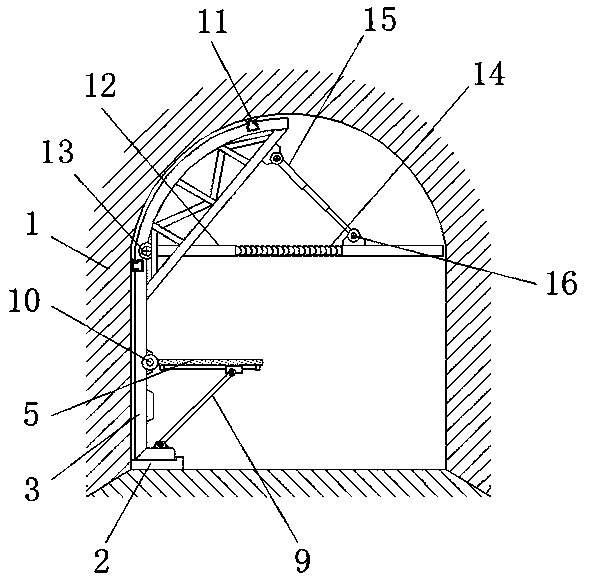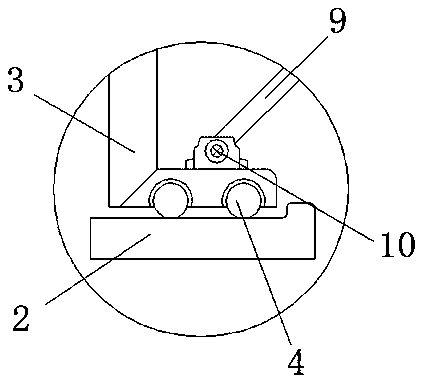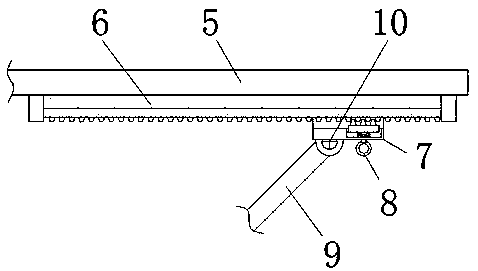Emergency rescue platform for tunnel
An emergency rescue and tunnel technology, applied in the field of tunnel rescue, can solve problems such as inconvenience of movement, tunnel collapse, and inconvenient functional rescue of the injured, so as to reduce space occupation and facilitate use.
- Summary
- Abstract
- Description
- Claims
- Application Information
AI Technical Summary
Problems solved by technology
Method used
Image
Examples
Embodiment 1
[0024] An emergency rescue platform for a tunnel, including a tunnel body 1, a guide pillow 2, a bracket 3, a ball 4, a rescue plate 5, a sliding rod 6, a sliding sleeve 7, a positioning member 8, a support rod 9, a first rotating shaft support 10, Slide rail 11, telescopic rod 12, second rotating shaft support 13, connecting spring 14, hydraulic rod 15, third rotating shaft support 16 and protective net 17, guide pillow 2 is fixedly installed at the bottom corner of tunnel body 1, And the bottom end of the support 3 is provided on the guide pillow 2, and a ball 4 is installed between the bottom of the support 3 and the guide pillow 2, and the inner side of the middle part of the support 3 is connected with a rescue board 5, and the bottom of the rescue board 5 is provided with a slide bar 6, and the sliding rod 6 is connected with a sliding sleeve 7, and the bottom of the sliding sleeve 7 is provided with a positioning member 8, and a supporting rod 9 is connected between the ...
Embodiment 2
[0025] Embodiment 2: The side section of the guide pillow 2 is set as an "L"-shaped structure, and the bottom of the guide pillow 2 and the bracket 3 are engaged with each other, and the bracket 3 is slidingly connected to the top of the guide pillow 2 through the ball 4 , the rescue board 5 and the bracket 3 constitute a relative overturn structure, and the connection end of the rescue board 5 and the bracket 3 and the connection end of the bracket 3 and the support rod 9 are relatively dislocated in the vertical plane, and the outer wall of the bracket 3 is in contact with the tunnel body 1 The inner walls are attached to each other.
[0026] The difference between this embodiment and Embodiment 1 is that the position of the bracket 3 is convenient to move, so that the bracket 3 can be guided when it is moved so that the rescue board 5 can be folded and stored when it is turned over, reducing the space occupied. At the same time, the structure of the bracket 3 is set , can s...
Embodiment 3
[0027] Embodiment 3: The sliding sleeve 7 and the sliding rod 6 form an engaged sliding connection, and the sliding sleeve 7 and the positioning member 8 form a relative lifting structure, and the top of the positioning member 8 and the bottom of the sliding rod 6 are both arranged in a strip shape The zigzag structure, the telescopic rod 12 is set to a shape with thick middle part and thin at both ends, and the maximum telescopic length of the telescopic rod 12 is greater than the maximum distance between the inner walls of the tunnel body 1, and the tunnel body 1 and the bracket 3 are rotatably connected, and the bracket 3 forms a triangular structure with the telescopic rod 12 and the hydraulic rod 15.
[0028] The difference between this embodiment and Embodiment 1 is that the turning angle of the rescue board 5 and the bracket 3 is changed by sliding the sliding sleeve 7 and the sliding rod 6, so as to facilitate the use and storage of the rescue board 5, and the structura...
PUM
 Login to View More
Login to View More Abstract
Description
Claims
Application Information
 Login to View More
Login to View More - R&D
- Intellectual Property
- Life Sciences
- Materials
- Tech Scout
- Unparalleled Data Quality
- Higher Quality Content
- 60% Fewer Hallucinations
Browse by: Latest US Patents, China's latest patents, Technical Efficacy Thesaurus, Application Domain, Technology Topic, Popular Technical Reports.
© 2025 PatSnap. All rights reserved.Legal|Privacy policy|Modern Slavery Act Transparency Statement|Sitemap|About US| Contact US: help@patsnap.com



